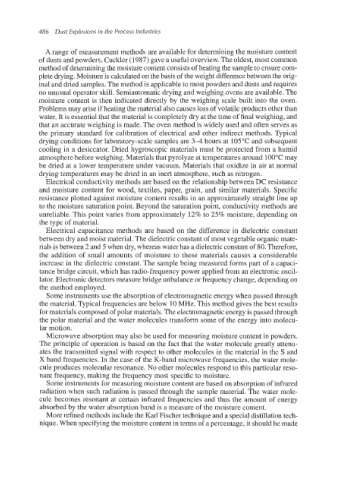Page 519 - Dust Explosions in the Process Industries
P. 519
486 Dust Explosions in the Process Industries
A range of measurement methods are available for determining the moisture content
of dusts and powders. Cuckler (1987) gave a useful overview. The oldest, most common
method of determining the moisture content consists of heating the sampleto ensure com-
plete drying. Moisture is calculatedon the basis of the weight differencebetween the orig-
inal and dried samples.The method is applicableto most powders and dusts and requires
no unusual operator skill. Semiautomaticdrying and weighing ovens are available.The
moisture content is then indicated directly by the weighing scale built into the oven.
Problemsmay arise if heating the material also causes loss of volatileproducts other than
water. It is essential that the material is completely dry at the time of final weighing, and
that an accurate weighing is made. The oven method is widely used and often serves as
the primary standard for calibration of electrical and other indirect methods. Typical
drying conditions for laboratory-scale samples are 3-4 hours at 105°C and subsequent
cooling in a desiccator. Dried hygroscopic materials must be protected from a humid
atmospherebefore weighing.Materialsthat pyrolyze at temperaturesaround 100°Cmay
be dried at a lower temperature under vacuum. Materials that oxidize in air at normal
drying temperatures may be dried in an inert atmosphere, such as nitrogen.
Electrical conductivity methods are based on the relationship between DC resistance
and moisture content for wood, textiles, paper, grain, and similar materials. Specific
resistance plotted against moisture content results in an approximately straight line up
to the moisture saturation point. Beyond the saturation point, conductivity methods are
unreliable. This point varies from approximately 12% to 25% moisture, depending on
the type of material.
Electrical capacitance methods are based on the difference in dielectric constant
between dry and moist material. The dielectric constant of most vegetable organic mate-
rials is between 2 and 5 when dry, whereas water has a dielectricconstant of 80. Therefore,
the addition of small amounts of moisture to these materials causes a considerable
increase in the dielectric constant. The sample being measured forms part of a capaci-
tance bridge circuit, which has radio-frequencypower applied from an electronic oscil-
lator. Electronic detectorsmeasurebridge unbalance or frequency change, dependingon
the method employed.
Some instruments use the absorption of electromagneticenergy when passed through
the material. Typical frequencies are below 10 MHz. This method gives the best results
for materials composed of polar materials.The electromagneticenergy is passed through
the polar material and the water molecules transform some of the energy into molecu-
lar motion.
Microwave absorption may also be used for measuring moisture content in powders.
The principle of operation is based on the fact that the water molecule greatly attenu-
ates the transmitted signal with respect to other molecules in the material in the S and
X band frequencies. In the case of the K-band microwave frequencies, the water mole-
cule produces molecular resonance. No other molecules respond to this particular reso-
nant frequency,making the frequency most specific to moisture.
Some instruments for measuring moisture content are based on absorption of infrared
radiation when such radiation is passed through the sample material. The water mole-
cule becomes resonant at certain infrared frequencies and thus the amount of energy
absorbed by the water absorption band is a measure of the moisture content.
More refinedmethods include the Karl Fischer technique and a special distillation tech-
nique. When specifyingthe moisture content in terms of a percentage,it should be made

